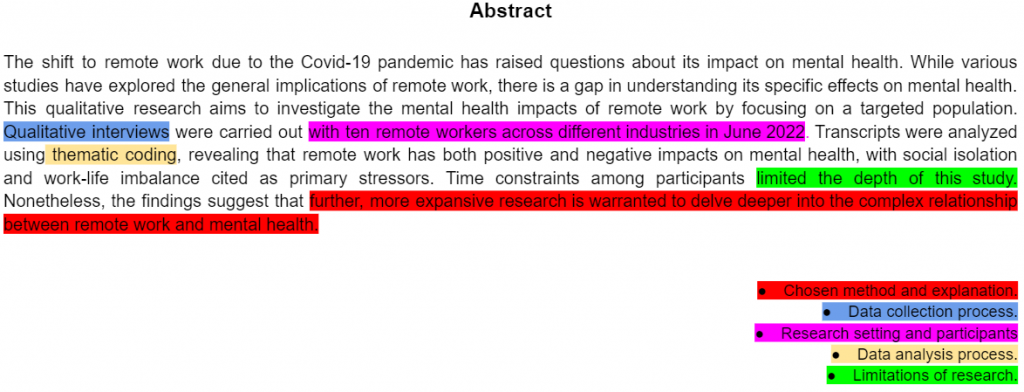Launch your academic journey with this complete guide to research methodology. Designed specifically for students, this guide simplifies the process of conducting thorough and valuable research. Learn how to choose the appropriate methods for your study, whether qualitative, quantitative, or mixed methods and understand the nuances that make your research believable and impactful. This is your essential roadmap for scholarly exploration, offering step-by-step guidance for every stage of your research project.
Research methodology definition
In straightforward terms, the concept of research methodology acts as the strategic plan for any exploration. It changes based on the particular questions the study seeks to answer. Essentially, a research methodology is the specific toolkit of methods selected to dive into a particular area of search.
To opt for the right methodology, you must consider your research interests as well as the type and form of data you plan to gather and analyze.

Research methodology types
Navigating the landscape of research methodology can be overwhelming due to the multitude of options available. While the main methodologies often center around qualitative, quantitative, and mixed-method strategies, the variety within these primary categories is expansive. It’s essential to select the methodology that best aligns with your research goals, whether it involves analyzing numerical trends, leading in-depth explorations of human experiences, or a combination of both methods.
In the sections that follow, we will delve deeper into each of these core methodologies: qualitative, quantitative, and mixed methods. We will examine their sub-types and offer guidance on when and how to employ them in your research efforts.
Quantitative research methodology
Quantitative research is a dominant methodology that primarily focuses on collecting and analyzing numerical data. This research process is employed in a wide range of disciplines, including but not limited to economics, marketing, psychology, and public health. Using statistical tools to interpret the data, researchers commonly use structured methods like surveys or controlled experiments to collect their information. In this section, we aim to explain two main types of quantitative research: Descriptive and Experimental.
| Descriptive quantitative research | Experimental quantitative research | |
| Objective | To describe a phenomenon through quantifiable data. | To prove cause-and-effect relationships through quantifiable data. |
| Example question | How many women voted for a specific presidential candidate? | Does implementing a new teaching method improve student test scores? |
| Initial step | Begins with systematic data collection rather than hypothesis formation. | Begins with a specific predictive statement that sets the course of the research (a hypothesis). |
| Hypothesis | A hypothesis is usually not formulated at the beginning. | A well-defined hypothesis is used to make a specific prediction about the outcome of the research. |
| Variables | N/A (not applicable) | Independent variable (teaching method), Dependent variable (student test scores) |
| Procedure | N/A (not applicable) | Design and execution of an experiment to manipulate the independent variable and calculate its impact on the dependent variable. |
| Note | Data is charged and summarized for description. | Collected numerical data is analyzed to test the hypothesis and confirm or disprove its validity. |
Descriptive and Experimental research serve as fundamental principles within the field of quantitative research methodology. Each has its unique strengths and applications. Descriptive research provides valuable images of specific phenomena, ideal for initial investigations or large-scale surveys. On the other hand, Experimental research dives deeper, exploring cause-and-effect dynamics in controlled settings.
The choice between the two should align with your research objectives, whether you desire to simply describe a situation or test a specific hypothesis. Understanding the differences between these two can guide researchers in designing more effective and meaningful studies.
Qualitative research methodology
Qualitative research focuses on the collection and analysis of non-numerical data like written or spoken words. It is often used to delve into people’s lived experiences and is general in disciplines like social anthropology, sociology, and psychology. The primary data collection methods usually involve interviews, participant observation, and textual analysis. Below, we outline three key types of qualitative research: Ethnography, Narrative research, and Case studies.
| Ethnography | Narrative research | Case studies | |
| Objective | Study of cultures and social relations through direct statement. | Understanding the lived experiences of specific individuals through their life stories. | Investigating a specific phenomenon within a specific context. |
| Main data source | Detailed field notes from in-depth observations. | Long interviews with individuals. | Multiple methods, including statements and interviews. |
| Typical researchers | Ethnographers | Qualitative researchers focused on narrative. | Qualitative researchers focused on specific phenomena within unique contexts. |
| Example | Studying the impact of religion in a community. | Recording the life stories of survivors of a natural disaster. | Researching how a natural disaster impacts an elementary school. |
Each of these types of qualitative research has its own set of goals, methods, and applications. Ethnography aims to explore cultural behaviors, Narrative research seeks to understand individual experiences, and Case studies aim to understand phenomena in specific settings. These methods offer rich, contextual insights that are valuable for understanding the complexities of human behavior and social phenomena.
Mixed-method research
Mixed-methods research combines qualitative and quantitative techniques to offer a more comprehensive view of a research problem. For instance, in a study exploring the impact of a new public transportation system on a community, researchers could employ a multi-pronged strategy:
- Quantitative methods. Surveys could be performed to collect data on metrics such as usage rates, commute times, and overall accessibility.
- Qualitative methods. Focus group discussions or one-on-one interviews could be carried out with community members to qualitatively measure their satisfaction, concerns, or recommendations regarding the new system.
This integrated approach is particularly popular in disciplines like urban planning, public policy, and social sciences.
When deciding on a research methodology, researchers should consider their study’s main objectives:
- If the research seeks to collect numerical data for statistical analysis, a quantitative approach would be most appropriate.
- If the goal is to understand subjective experiences, opinions, or social contexts, a qualitative approach should be embraced.
- For a more holistic understanding of the research problem, a mixed-methods approach could be the most effective.
By coordinating their methodology with their study objectives, researchers can collect more targeted and meaningful data.

9 components of research methodology
After researchers have decided which research methodology best aligns with the objectives of their study, the next step is to articulate its individual components. These components—covering everything from why they chose a particular methodology to the ethical factors they need to consider—are not just procedural checkpoints. They serve as posts that provide a complete and logical structure to the research work. Each element has its own set of complexities and considerations, making it critical for researchers to thoroughly address them to provide a full, transparent, and ethically sound study.
1. Reasoning behind the choice of methodology
The initial and pivotal component of a research methodology is the justification for the selected method. Researchers should carefully consider the rationale behind their chosen approach to ensure it aligns logically with the study’s objectives.
For example:
- When selecting a research method for a study in literature, the researchers must first delineate their research goals. They might be interested in exploring how accurately a historical novel reflects the actual experiences of individuals during that period. In this case, conducting qualitative interviews with individuals who lived through the events described in the book could be an effective way to meet their objectives.
- Alternatively, if the aim is to understand the public perception of a text at the time it was published, the researcher could gain valuable insights by reviewing archival materials, such as newspaper articles or contemporary reviews from that era.
2. Locating the research environment
Another key element in designing a research methodology is identifying the research environment, which dictates where the actual research activities will take place. The setting not only influences the logistics of the study but can also affect the quality and reliability of the data collected.
For example:
- In a qualitative research study that employs interviews, researchers must choose not only the location but also the timing of these interviews. Choices range from a formal office to a more intimate home environment, each with its own impact on data collection. The timing might also be changed according to the availability and comfort level of the participants. There are also additional considerations for qualitative interviews, such as:
- Sound and distractions. Confirm that the setting is quiet and free from distractions for both the interviewer and interviewee.
- Recording equipment. Decide in advance what kind of equipment will be used to record the interview and how it will be set up in the selected setting.
- For those conducting a quantitative survey, options range from online questionnaires accessible from anywhere to paper-based surveys administered in specific environments like classrooms or corporate settings. When weighing these options, important factors to consider include:
- Reach and demographics. Online surveys might have a wider reach, but could also introduce bias if specific demographic groups are less likely to have internet access.
- Response rates. The setting can influence how many people actually complete the survey. For instance, in-person surveys may result in higher completion rates.
When selecting the research environment, it’s essential to revisit the main objectives of the study. For instance, if a researcher seeks to delve deeply into personal experiences related to a historical event, capturing non-verbal signals like facial expressions and body language can be vital. Consequently, conducting interviews in a setting where participants feel comfortable, such as in their own homes, could produce richer, more nuanced data.
3. Criteria for participant selection
Another crucial component in formulating a research methodology is the process of identifying and selecting study participants. The chosen participants should ideally fall within the demographic or category that is central to answering the research question or meeting the study objectives.
For example:
- If a qualitative researcher is investigating the mental health impacts of remote work, it would be appropriate to include employees who have transitioned to remote work settings. Selection criteria could include a variety of factors, such as the type of job, age, gender, and years of work experience.
- In some cases, researchers may not need to actively recruit participants. For instance, if the study involves analyzing public speeches of politicians, the data already exists and there’s no need for participant recruitment.
Depending on the specific objectives and the nature of the research design, various strategies for participant selection may be required:
- Quantitative research. For studies that focus on numerical data, a random sampling method may be suitable to ensure a representative and diverse sample of participants.
- Specialized populations. In cases where the research aims to study a specialized group, such as military veterans with PTSD (Post-traumatic stress disorder), random selection may not be appropriate due to the unique characteristics of the participant pool.
In every case, it’s critical for researchers to explicitly state how participants were selected and to provide justification for this selection method.
This meticulous approach to participant selection enhances the validity and reliability of the research, making the findings more applicable and credible.
4. Ethical approval and considerations
Ethical considerations should never be an afterthought in any research work. Providing the ethical integrity of research not only protects the subjects but also improves the credibility and applicability of the research findings. Below are some key areas for ethical considerations:
- Review board approval. For research concerning human subjects, getting ethical approval from a review board is often required.
- Data privacy. Ethical considerations also apply in contexts such as data privacy in secondary data analysis.
- Conflict of interest. Recognizing potential conflicts of interest is another ethical responsibility.
- Informed support. Researchers should detail the processes for getting informed consent from participants.
- Addressing ethical concerns. It’s important to outline how ethical risks have been mitigated, which could involve processes and protocols for ethical dilemmas.
Paying close attention to ethical considerations throughout the research process is crucial for keeping the study’s integrity and credibility.

5. Ensuring accuracy and trustworthiness in research
Ensuring the accuracy and trustworthiness of research methodology is crucial. Accuracy refers to how close the research findings are to the actual truth, while trustworthiness is a broader term that encompasses various aspects of research quality, such as credibility, transferability, dependability, and confirmability.
For example:
- In a qualitative study involving interviews, one should ask: Do the interview questions consistently yield the same type of information from different participants, demonstrating reliability? Are these questions valid in measuring what they are intended to measure? In quantitative research, researchers often inquire whether their measurement scales or instruments have been previously validated in similar research contexts.
Researchers should clearly outline how they plan to ensure both accuracy and trustworthiness in their study, through means such as pilot testing, expert review, statistical analysis, or other methods.
6. Choosing data collection tools
In developing a research methodology, researchers must make critical decisions about the types of data they require, which in turn influences their choice between primary and secondary sources.
- Primary sources. These are original, firsthand sources of information that are particularly useful for directly addressing the research questions. Examples include qualitative interviews and customized surveys in quantitative studies.
- Secondary sources. These are second-hand sources that provide data based on someone else’s research or experience. They can offer a wider context and include scholarly articles and textbooks.
Once the type of data source is selected, the next task is to pick the appropriate data collection instruments:
- Qualitative instruments. In qualitative research, methods like interviews might be chosen. The ‘interview protocol,’ which includes the list of questions and the interview script, serves as the data collection tool.
- Literary analysis. In studies focused on literary analysis, the main text or multiple texts that flash the research usually serve as the primary source of data. Secondary data could include historical sources like reviews or articles published around the time the text was written.
The meticulous selection of data sources and collection instruments is crucial in preparing a robust research methodology. Your choices should align closely with the research questions and objectives to guarantee the validity and reliability of the findings.
7. Data analysis methods
Another key aspect of a research methodology is the methods of data analysis. This varies based on the type of data collected and the objectives set forth by the researcher. Whether you’re working with qualitative or quantitative data, your approach to interpreting it will be distinctly different.
For example:
- Qualitative data. Researchers often “code” qualitative data thematically, seeking to identify major concepts or patterns within the information. This could involve coding interview transcripts to discover recurring themes or sentiments.
- Quantitative data. In contrast, quantitative data usually necessitate statistical methods for analysis. Researchers often use visual aids such as charts and graphs to illustrate trends and relationships in the data.
- Literary research. When focusing on literary studies, the data analysis may involve thematic exploration and evaluation of secondary sources that comment on the text in question.
After outlining your approach to data analysis, you may wish to conclude this section by highlighting how the chosen methods align with your research questions and objectives, thus guaranteeing the integrity and validity of your results.
8. Recognizing research limitations
As an almost concluding step in the research methodology, researchers should openly discuss the constraints and limitations inherent to their study, along with the ethical considerations associated with it. No research effort can fully address every aspect of a subject; therefore, all studies have inherent limitations:
- Financial and time constraints. For example, budget limitations or time restrictions may impact the number of participants a researcher can include.
- Scope of the study. Limitations may also affect the scope of the research, including topics or questions that could not be addressed.
- Ethical guidelines. It is crucial to explicitly state the ethical standards followed in the research, guaranteeing that relevant ethical protocols were both identified and adhered to.
Recognizing these limitations and ethical considerations is crucial in creating a clear and self-aware research methodology and paper.
Streamlining academic excellence with our specialized tools
In the journey of academic research, the final step involves refining and validating your work. Our platform offers services designed to improve and safeguard your research efforts:
- Innovative plagiarism detection and removal. Our trusted global plagiarism checker guarantees the originality of your research, sticking to the highest academic standards. Beyond detection, our service also offers solutions for plagiarism removal, guiding you in rephrasing or restructuring content while keeping the essence of your work.
- Expert proofreading assistance. Transform your research paper into a polished masterpiece with our professional proofreading service. Our experts will fine-tune your writing for maximum clarity, coherence, and impact, ensuring your research is communicated most effectively.
These tools are instrumental in ensuring that your research not only complies with academic standards but also shines in terms of clarity and precision. Sign up and experience how our platform can significantly enhance the quality of your academic endeavors.

The significance of a well-structured research methodology
Research methodology plays a key role in structuring the research process and confirming its validity and effectiveness. This research methodology acts as a roadmap, providing clear instructions for every step of the research process, including ethical concerns, data gathering, and analysis. A meticulously executed research methodology not only sticks to ethical protocols but also promotes the study’s credibility and applicability.
Beyond its essential function in guiding the research process, the research methodology serves a dual purpose for readers and future researchers:
- Relevance check. Including a brief description of the research method in the abstract helps other researchers quickly see if the study fits with what they’re studying.
- Methodological transparency. Providing a detailed account of the research methodology in a dedicated section of the paper allows readers to gain an in-depth understanding of the methods and techniques used.
When introducing the research methodology in the abstract, it’s crucial to cover key aspects:
- Type of research and its justification
- Research setting and participants
- Data collection procedures
- Data analysis techniques
- Research limitations
By offering this brief overview in the abstract, you help prospective readers quickly understand your study’s design, influencing whether they will continue reading the paper. A subsequent, more detailed ‘Research Methodology’ section should follow, elaborating on each component of the methodology in greater depth.
Example of the research methodology
Research methodologies serve as the backbone of any scholarly inquiry, providing a structured approach to investigating questions and problems. In qualitative research, methodologies are particularly important for ensuring that data collection and analysis are aligned with the research objectives. To better illustrate how a research methodology might be outlined in a study, let’s look at an example focused on investigating the mental health impacts of remote work during the Covid-19 pandemic.
For example:

Conclusion
| The role of a well-crafted research methodology cannot be overstated. Serving as a roadmap, it provides both the researcher and the reader with a reliable guide to the study’s design, objectives, and validity. This guide walks you through the complex landscape of research methodology, offering critical insights into how to align your methods with your study’s goals. Doing so, not only guarantees the validity and credibility of your research but also contributes to its impact and applicability for future studies and the wider academic community. |
